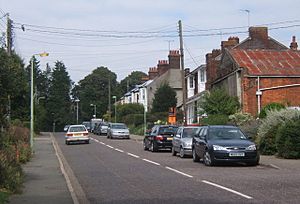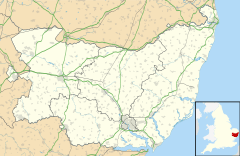Shotley Gate facts for kids
Quick facts for kids Shotley Gate |
|
|---|---|
 |
|
| Area | 0.4900 km2 (0.1892 sq mi) |
| Population | 1,461 (2020 estimate) |
| • Density | 2,982/km2 (7,720/sq mi) |
| Civil parish | |
| District |
|
| Shire county | |
| Region | |
| Country | England |
| Sovereign state | United Kingdom |
| Post town | IPSWICH |
| Postcode district | IP9 |
| Dialling code | 01473 |
| EU Parliament | East of England |
| UK Parliament |
|
Shotley Gate is a small place in the civil parish of Shotley, located in Suffolk, England. It sits right at the end of the Shotley Peninsula. It's the biggest village in the Shotley area. In 2020, about 1,461 people lived there. Shotley Gate has a pub called the Bristol Arms, which used to be known as the Shotley Gate Inn. The village grew up around a road called Bristol Hill.
Contents
Shotley Gate's Early History
Around 800 AD, the Vikings (also known as the Danes) started to arrive in this part of England. In 878, a peace agreement called the Peace of Wedmore was made. This agreement gave all the land north of the old Roman road, Watling Street, to the Viking leader, Guthrum. This meant Shotley became part of an area known as Danelaw, which was ruled by the Vikings.
However, this peace did not last long. After the Vikings tried to attack Kent, Alfred the Great, who was King of Wessex, fought back. He attacked the Vikings in East Anglia. The Anglo-Saxon Chronicle, a historical record, describes an event from the year 885. It says that King Alfred sent ships from Kent to East Anglia. These ships met 16 Viking pirate ships at the mouth of the River Stour. Alfred's fleet won, taking the ships and defeating the Vikings. But on their way back, they met a larger Viking fleet and lost the battle.
Why is it Called Bloody Point?
Some people think that a place in Shotley called Bloody Point got its name from this battle. However, back then, the river entered the sea north of Felixstowe. So, the area might not have been seen as the mouth of the Stour. The name could also have come later. In the next century, Vikings returned to the river estuary. They attacked and robbed Ipswich twice.
Shotley Gate and the surrounding area have always been important. Their location helps protect the ports of Felixstowe, Harwich, and Ipswich. Because of this, strong defenses called the Shotley Battery were built there in 1865.
Kings and Battles at Shotley
King Edward III of England once stayed here. This was early in the Hundred Years War, before the big sea battle called the Battle of Sluys. Important documents signed by him, now kept in the National Archive, end with the words "at Shotley."
Shotley Gate was also home to HMS Ganges. This was a special training center for boys who wanted to join the Royal Navy. It was sometimes called RNTE Shotley.
The original HMS Ganges was a large ship made of teak wood. It was built in 1821 and stopped being used as a ship in 1861. In 1899, it was moved to Shotley. By 1905, the training moved from the ship to buildings on land. Many naval sailors in the 20th century trained here. This included boys joining in peacetime and men during both World Wars. The training center closed in 1976. The land was then sold for new buildings. In June 2011, the Babergh District Council made the site a Conservation Area. This means it is protected for its historical importance.
Visit the HMS Ganges Museum
Today, you can visit the HMS Ganges Museum. It is open on Saturdays, Sundays, and Bank Holidays. You can visit from Easter until the end of October, between 11:00 AM and 5:00 PM. The museum has many interesting items from the old training base. These include old photographs and original documents.
See also
 In Spanish: Shotley Gate para niños
In Spanish: Shotley Gate para niños


